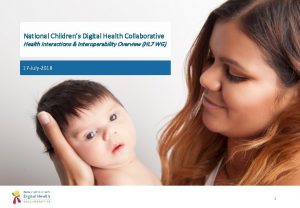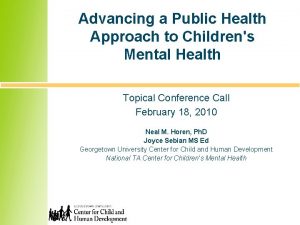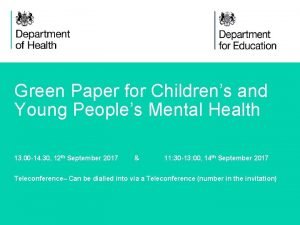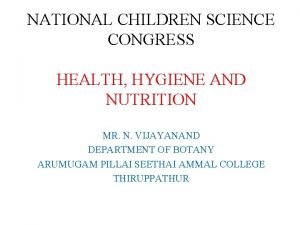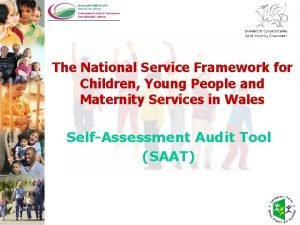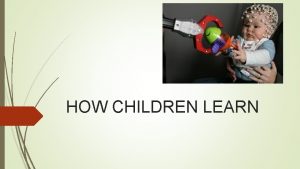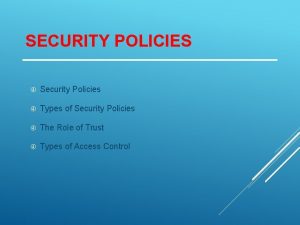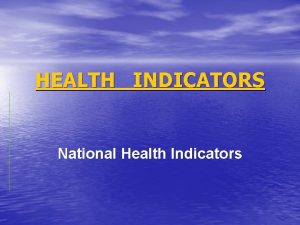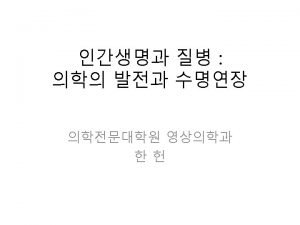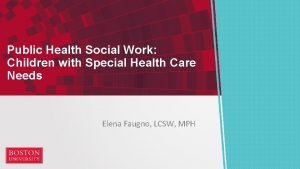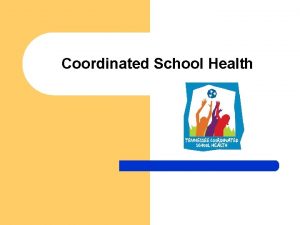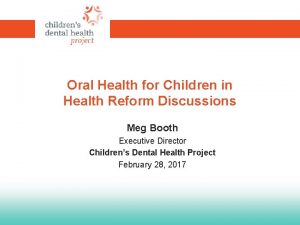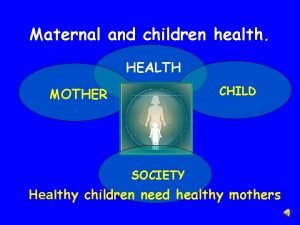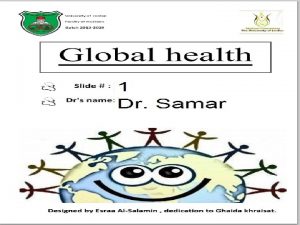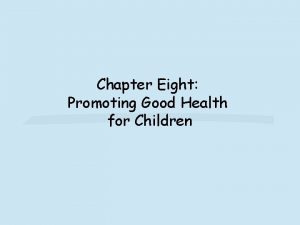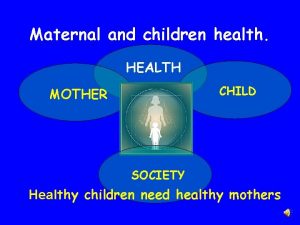NATIONAL HEALTH POLICIES FOR CHILDREN NATIONAL POLICIES FOR






























































- Slides: 62


NATIONAL HEALTH POLICIES FOR CHILDREN

NATIONAL POLICIES FOR CHILDREN �August 1974 GOALS : o The National policy for education adopted by parliament gives direction to state to make policies required to meet educational needs of children. o It shall be the policy of state to provide adequate services to children both before and after birth & through out the period of growth to ensure full physical, mental and social development. *all children in the country enjoy optimum and attain the balanced growth.

PRIORITIES IN PROGRAMME FORMULATION �Preventive and promotive aspects of children and child health. �Nutrition for infants and children in the preschool age along with nutrition for nursing and expectant mother. �Maintenance, education and training of orphans and destitute children. �Creches and other facilities for care of children of working and ailing mothers. �Care, education and training of handicapped children.

CONSTITUTIION OF NATIONAL CHILDRENS BOARD �National Children’s Board was constituted at state level to provide focus and ensure at different level continuous planning, review and coordination of all essential services. �Considerable expansion in health, nutrition, education and welfare services. �Rise in standard of living.

ROLE OF VOLUNTARY ORGANIZATIONS AND PEOPLE PARTICIPATION.

NATIONAL POLICY FOR CHILDREN 2011 �This policy is framed keeping in mind the Rights of All Children; a child being any person before, during and after birth until the age of 18 yrs. �Focuses on rights based approach from need based approach. �It outlines the way in which Government of India aims to safeguard, inform, support and empower children, both in their individual situation and in development of country as a whole. �Provision of this policy can be taken as a guide for all other policies or programme's or legislations that impact lives of children.

VISION: �It aims to create a maturing, protective and enabling environment for children based on nondiscrimination, equity, justice and best interest of children in the country. �The state commits hereby to take all positive measures, legislative policies or otherwise to promote and safeguard the rights of all children to live and grow with equity, dignity, security and freedom with each children of his/her identity.

GUIDING PRINCIPLES 1. All children have equal rights irrespective of class, caste or gender. 2. Child rights are universal; inalienable, interdependent and indivisible. 3. The best interest of child shall be of paramount consideration in all actions and decisions; concerning children, whether undertaken by state, court laws, administrative authorities, legislative bodies or social welfare institutions.

4. The safety of all children shall be of prime importance and they shall be protected from harm, abuse, neglect, violence, maltreatment and exploitation. 5. The physical, emotional, cognitive and social development of child shall be addressed in totality within family and society at large. 6. The physical, environmental including non-instructional care is most conductive for all round development of children. 7. The principles of justice, equality and nondiscrimination shall guide all action concerning child whether under taken by state or an authority or institution or an individual.

8. Respect for views of children in accordance with age and maturity of child should be assure in all matters affecting them. 9. Consultation and participation of children in an age appropriate manner and their evolving capacities in all matters in an unalienable rights of every child. 10. Take positive measures for promotion, and protection of the rights of all children shall be primary responsibility of the state.

STRATEGIC OBJECTIVE The state shall commit to: v Ensure survival, development, health, nutrition, clean water and sanitation to prevent child mortality, malnutrition, diseases and disabilities. v Ensure highest standards of human, financial and infrastructural resources. So that all children develop to their full potential. v Establish and strengthen the safety net of strong laws, institutions, procedures and enforcement machinery to ensure the protection of all children and reduce their vulnerability.

�Create an environment where in children’s views, choices, perceptions and aspirations are sought in all matters affecting them. �Network and collaborate locally, regionally, nationally and internationally with other stake holders in order to safeguard and promote rights of all children. �Ensure free, compulsory, quality education and development of all children. �Reduce gender, religion, economic and social disparities that affect rights of all children.

DEVELOPMENT & EDUCATION CARE & NUTRITION PROTECTION SURVIVAL & HEALTH PRIORITIES ADVOCACY & PARTNERSHIP PARTICIPATIO N

NATIONAL HEALTH POLICY

NEED FOR HEALTH POLICY IN INDIA �Aims to eliminate poverty, ignorance, ill health and directs the state to raise its public health status of its people and their quality of life is its prime responsibility.

URGENCY FOR NATIONAL HEALTH POLICY �To achieve goals of revised 20 point program as a long term basis, it also becomes essential that nation evolves a clear cut health policy of it own, so that problems of haves and have-not's could be resolved in matters of health which is basic to human development and ultimately contributes to productivity of a nation.

20 – point programme Points directly or indirectly related to health, Point 1 – attack of rural poverty Point 7 – clean drinking water Point 8 - health for all Point 9 – two – child norm Point 10 – expansion of education Point 14 – housing for people Point 15 – improvement of slum Point 17 – protection of the environment

NATIONAL HEALTH POLICY FOR CHILDREN - 1983 �MAJOR DIRECTION ARE: �Provision of universal comprehensive PHC services with special emphasis on preventive, promotive and rehabilitative aspects. �Serving small family norms through efforts moving towards goal of population stabilization. �Mobilizing the untapped heath resources and encouraging investment by private sectors. �To remove existing regional imbalances and it provide services within reach of all.

APPROACHES �To extend out the reach of PHC services through a network of health center based organized support of health volunteers available, auxiliaries, paramedical workers of both sexes. �Inter-nesting efforts of NGO’s, voluntary organization with government efforts in planned integrated manner. �Improving quality of training of frontline workers and support manpower in health. �Planning for optimal utilization of specialists at higher levels of hierarchical structure.

�Creation of nation wide chain of sanitary and epidemiological unit. �Fullest utilization of domiciliary care and field health camp approach to reduce pressure on curative regards, TB, leprosy, blindness, normal deliveries, and family planning measures.

priorities NUTRITION PREVENTION OF FOOD ADULTRATION AND QUALITY OF DRUG WATER SUPPLY AND SANITATION ENVIRONMENTAL PROTECTION

IMMUNIZATION PROGRAMME MATERNAL AND CHILD HEALTH SERVICES SCHOOL HEALTH PROGRAMME OCCUPATIONAL HEALTH SERVICES

Elements �Solving health problems �Supplying drinking water and basic sanitation �Reduction in existing imbalances between and in health services by increasing infrastructures �Establishing health information system. �Provision of legislative support to health projects and health promotion. �Coordination of different systems of medicine.

components �Reduction of health disparities of health services. �Promotion of elementary education. �An integral rural development approach. �Welfare of women and children. �Population control strategies.

NATIONAL HEALTH POLICY - 2002 �New policy revised by health and family welfare, govt. of India. MAIN POWERPOINT: �To achieve acceptable standard of good health amongst the general public, primarily focused on diseases which are principally contributing to disease burden.

Goals of national health policy �To eradicate polio and yaws by 2005 �To eliminate leprosy by 2005 �To eliminate Kala-Azar by 2010 �TO ELIMINATE FILARIASIS BY 2015 �Decreasing mortality rate by 50% on TB by 2010 �Decreasing malaria and other vector born diseases by 2010

�Decrease in preventive blindness by 2010 �Increasing utilization of primary health services from 20 – 75% by 2010. �Decrease mortality of infant to 30/1000 live births and maternal mortality rate 100/1, 00, 000 by 2010 �Establish integrated disease surveillance by 2005

LAWS AND ORDINANCE RELATED TO CHILDREN.

�LAW: law is a system of rules and guide lines which are enforced through social institutions to govern behaviour. ORDINANCE: A custom or practice established by long usage. may also refers to law.

RIGHTS OF CHILDREN 1. The right to survival 2. The right to protection 3. The right to development 4. The right to participation 5. The right to provision

6. The economic, social and cultural rights 7. The right to expression 8. The right to recreation 9. the right to name and nationality 10. The right to take pride in achievements 11. The right to protection from neglect

1. The children act, 1960 �Amended in 1977 �Emphasis on provision of care, maintenance, welfare, training, education and rehabilitation of the delinquent child. �It cover the neglected and destitute, socially handicapped, victimized and delinquent children.

�Article 39, says that: - “ the state shall in particular direct its policy towards securing that childhood and youth are protected against moral and material abandonment.

2. THE CHILD MARRIAGE RESTRAIN ACT, 1978. �In 1929, the sharda act was enacted forbidding the practice of child marriage. �The Child Marriage Restrain Act, 1978 – rises the legal age of marriage for girls from 15 yrs to 18 yrs boys from 18 yrs to 21 yrs. �It is a preventive measure for maternal and infant mortality and morbidity.


3. CHILD LABOUR ACT, 1986 � According to this act, except in the process of family-based work or recognized schoolbased activities, children’s are not allowed to work in occupations concerned with – � Passengers, goods mail transport by railway � Cement manufacturing, cloth painting � Building construction operation � Dying, weaving, beedi making, wool cleaning � Printing, mica cutting, splitting…. .

Hours and period of work �The period of work should be fixed only for 3 hrs and no child shall work more than 3 hrs. �No child shall be allowed to work between 7 pm – 8 pm.

4. EDUCATION FOR ALL HANDICAPPED CHILDREN ACT. �Arouse from federal case law, with the aim of special education and related services should be designed to meet the unique learning needs of eligible children with disabilities. �Should be prepared for further education, employment and independent living. �Disabilities include … intellectual disability, hearing impairment, speech or language impairment, visual impairment etc……………

5. CHILD ABUSE ACT, 1974 �Child abuse: can be defined as causing and permitting any harmful or offensive contact on child’s body and any communication or transaction of kind which frightens or shames the child. �The harm may be physical harm ( beating, kicking), emotional harm, sexual abuse or exploitation. � under this act, children are protected from exploitation or abuse.



6. JUVENILE JUSTICE ACT, 2000. �Recently amended in 2006. �This act defines juvenile/ child as a person who has not completed age of 18 years. It has 2 separate chapters: 1. for juvenile in conflict with law 2. for children in need for care and protection.

Juvenile in conflict with law, is a child who is alleged to have committed an offence, and Children in need of care and protection, are child who are neglected, abused, abandoned, victims of any armed conflict or natural calamities amongst others.

Provisions & procedures are implemented through: �Juvenile justice board �Child welfare committee �Institutional care through children home, shelter home, special homes and after care organizations. �Special juvenile policy unit �Non-institutional care through adoption, foster care, sponsorship and after care. �Juvenile justice fund �Selection committee � inspection committee

INFANT MILK SUBSTITUTE, FEEDING BOTTLES AND INFANT FOOD ACT, 1992 �CAME INTO EXISTANXE IN 1 st AUG 1993 �It prohibits the promotion of infant food, infant milk substitutes and feeding bottles as govt. of India committed to promote exclusive breast feeding for 1 st 6 months. Act was revised as Infant Milk Substitute, Feeding Bottle And Infant Food Amendment Act in 2003 and came into action on 1 st jan 2004

Goals set to be achieved by the year 2007 were: �Intensify nutrition and health education, thus (i) bring down prevalence of under weight below 3 yrs from 47% to 40% (ii) reduce prevalence of severe under nutrition in children in the age of o-6 yrs by 50%

�Enhance early initiation of breast feeding ( colostrum feed) from 15. 8% - 50%. �Enhance exclusive breast feeding rate for 1 st 6 months from 55. 2% to 80% �Enhance complementary feeding rate at 6 months from 33. 5% to 75%.

8. COMMISSION FOR PROTECTION OF CHILD RIGHTS ACT, 2005 �Provides for the constitution of national commission and state commission for protection of child rights and children’s court for providing speedy trial of offences against children or violation of child right.

9. PARENTAL KIDNAPING PREVENTION ACT �Is the care, control and maintenance of a child, which a court may award to one self the parents following a divorce or separation procedures.

10. Girl child act (compulsory education and welfare) Act, 2000. � A bill to provide free and compulsory minimum education for the girl child and other welfare measures to be undertaken by the state for her proper development. �STRATEGIES: 1. (i) this act may be called as girl child act (ii) it extends to whole of india (iii) it shall come into force at once.

2. In this act, unless otherwise the context require, (i) appropriate govt. (ii) girl child – any women below age of 16 yrs. 3. Appropriate govt. shall provide every girl child, (i) compulsory and free education upto matriculation level or secondary level (ii)study materials ( books, stationaries etc. . ) (iii)free hostel facilities (iv) school uniform, shoes, socks free of cost (v) scholarships

4. The appropriate govt. shall provide nutritious meals free of cost to all the girl students in schools, colleges, institutions, universities and hostels. 5. The appropriate govt. shall provide regular free medical aid and health care to every girl child through out the country. 6. Provision for vocational training. 7. The appropriate govt. shall provide proper and gainful employment to every girl child after completion of her education or vocational training.

8. It shall be the duty of the head of the family men/ women , to send every girl child of the family to school, colleges or institutions for recieving education or vocational training. 9. Whoever contravenes the provision of section 8, shall be punishable with imprisonment which may extend to 2 yrs or with fine of rs. 2000/- or both. 10. The central govt. may, by notification in the official gazette, make rules for carrying out the purposes of this act.

11. CHILD ADOPTION ACT. �The first modern adoption legislation, the Adoption of Children Act, was passed in the U. S. state of Massachusetts in 1851. �It required judges to determine that adoptive parents had “sufficient ability to bring up the child” and that “it is fit and proper that such adoption should take effect. �Modern adoption laws and practices aim to promote child welfare and are regarded as an integral part of government efforts to protect the interests of the young.

Child adoption law in india Indian citizens can adopt in India under three major legislations: • the Hindu Adoption and Maintenance Act of 1956, • the Guardians and Wards Act of 1890 and • the Juvenile Justice (Care and Protection) Act of 2000, amended in 2006.

The Hindu Adoption and Maintenance Act, 1956 (HAMA) This Act covers Hindus, Buddhists, Jains or Sikhs. Some relevant parts of the Act are: �Married couples or single adults can adopt; �Legally the man adopts with the consent of his wife; �A single man or woman can adopt; �If a biological child already exists in the family, a child of the opposite sex has to be adopted; �Children adopted under this Act get the same legal rights as a biological child might; � Children under the age of 15 years can be adopted; �A single man adopting a girl should be at least 21 years older than the child; �A single woman adopting a boy should be at least 21 years older than the child; and �Adoption under this act is irrevocable.

The Guardians and Wards Act, 1890 (GWA) The parent adopting is a ‘guardian’ and the child is a ‘ward’, meaning that the same rights of a biological child aren’t inherent; �Anyone under the age of 18 years can be a ward; �The guardianship can be revoked by the courts or by the guardian; �A will is required for any property/goods to be bequeathed to the child; � This will can be legally contested by ‘blood’ relatives; �Both spouses can legally be guardians (versus HAMA where the man adopts with the consent of his wife); and �Single people can adopt without any age difference restrictions.

The Juvenile Justice (Care and Protection) Act of 2000, amended in 2006 (JJ Act) The Amendment Act of 2006 has since expanded the provisions. The main strengths of this Act are: �Any Indian citizen can adopt a child who is legally free for adoption; �The adoptee gets the same rights that a biological child might; �The religion of the adoptive parent(s) is not relevant; �Single people can adopt; �The adoption is irrevocable; �Some time limits have been set to ensure that children are considered legally free for adoption earlier; and �The thrust is on the best interest of the child



 National child policy 1974
National child policy 1974 Existanxe
Existanxe National programmes related to child health and welfare ppt
National programmes related to child health and welfare ppt National children's digital health collaborative
National children's digital health collaborative Children's mental health
Children's mental health Green paper children's mental health
Green paper children's mental health National children's science congress projects ideas
National children's science congress projects ideas National service framework children
National service framework children Formuö
Formuö Typiska novell drag
Typiska novell drag Tack för att ni lyssnade bild
Tack för att ni lyssnade bild Vad står k.r.å.k.a.n för
Vad står k.r.å.k.a.n för Shingelfrisyren
Shingelfrisyren En lathund för arbete med kontinuitetshantering
En lathund för arbete med kontinuitetshantering Kassaregister ideell förening
Kassaregister ideell förening Vilotidsbok
Vilotidsbok Anatomi organ reproduksi
Anatomi organ reproduksi Vad är densitet
Vad är densitet Datorkunskap för nybörjare
Datorkunskap för nybörjare Boverket ka
Boverket ka Debatt artikel mall
Debatt artikel mall För och nackdelar med firo
För och nackdelar med firo Nyckelkompetenser för livslångt lärande
Nyckelkompetenser för livslångt lärande Påbyggnader för flakfordon
Påbyggnader för flakfordon Formel för lufttryck
Formel för lufttryck Svenskt ramverk för digital samverkan
Svenskt ramverk för digital samverkan Lyckans minut erik lindorm analys
Lyckans minut erik lindorm analys Presentera för publik crossboss
Presentera för publik crossboss Vad är ett minoritetsspråk
Vad är ett minoritetsspråk Bat mitza
Bat mitza Treserva lathund
Treserva lathund Fimbrietratt
Fimbrietratt Bästa kameran för astrofoto
Bästa kameran för astrofoto Cks
Cks Programskede byggprocessen
Programskede byggprocessen Bra mat för unga idrottare
Bra mat för unga idrottare Verktyg för automatisering av utbetalningar
Verktyg för automatisering av utbetalningar Rutin för avvikelsehantering
Rutin för avvikelsehantering Smärtskolan kunskap för livet
Smärtskolan kunskap för livet Ministerstyre för och nackdelar
Ministerstyre för och nackdelar Tack för att ni har lyssnat
Tack för att ni har lyssnat Vad är referatmarkeringar
Vad är referatmarkeringar Redogör för vad psykologi är
Redogör för vad psykologi är Stål för stötfångarsystem
Stål för stötfångarsystem Tack för att ni har lyssnat
Tack för att ni har lyssnat Borra hål för knoppar
Borra hål för knoppar Vilken grundregel finns det för tronföljden i sverige?
Vilken grundregel finns det för tronföljden i sverige? Formel för standardavvikelse
Formel för standardavvikelse Tack för att ni har lyssnat
Tack för att ni har lyssnat Steg för steg rita
Steg för steg rita Vad är verksamhetsanalys
Vad är verksamhetsanalys Tobinskatten för och nackdelar
Tobinskatten för och nackdelar Toppslätskivling effekt
Toppslätskivling effekt Datumr
Datumr Egg för emanuel
Egg för emanuel Elektronik för barn
Elektronik för barn Plagg i rom
Plagg i rom Strategi för svensk viltförvaltning
Strategi för svensk viltförvaltning Kung dog 1611
Kung dog 1611 Humanitr
Humanitr Romarriket tidslinje
Romarriket tidslinje Tack för att ni lyssnade
Tack för att ni lyssnade Multiplikation med uppställning
Multiplikation med uppställning



